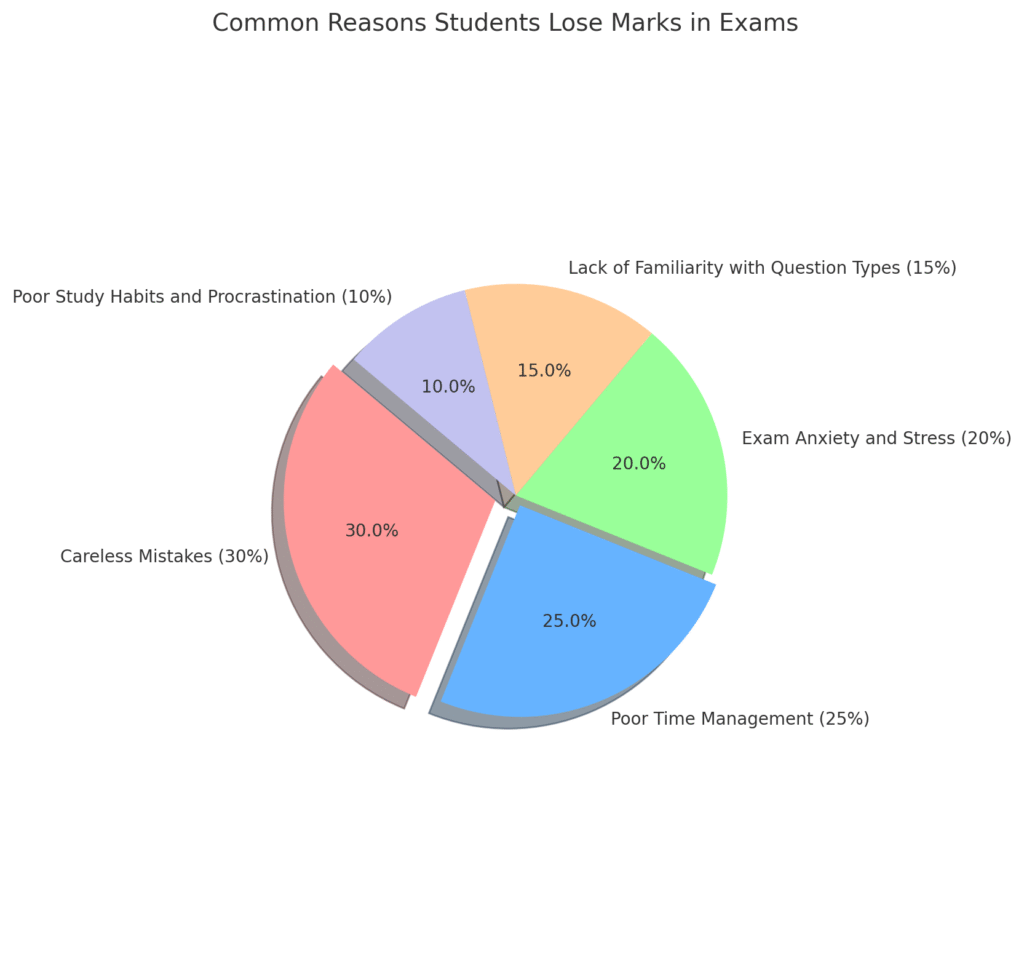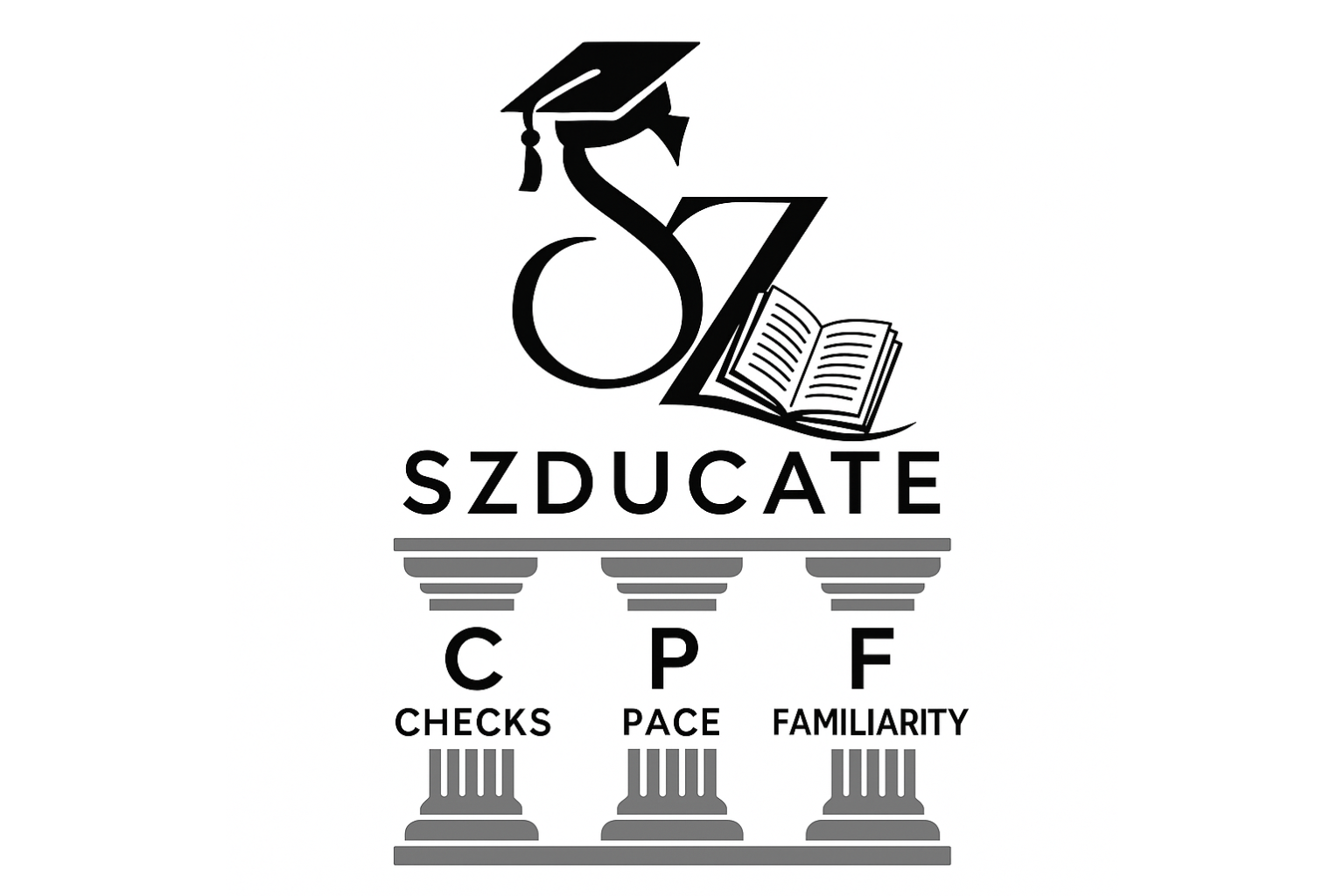The Szducate Method
Have you ever wondered why a student who studies hard and understands all the concepts still doesn’t score well?
It’s a frustrating reality for many parents and students. After months of studying and completing stacks of past exam papers, the final result still doesn’t reflect the effort. Many students preparing for the O-Level Maths exams fall short not because they lack knowledge, but because they lose marks mainly due to careless mistakes and poor time management.
To address this, I have developed the Szducate Method — a structured exam techniques system based on years of teaching and analysing why students underperform. It encompasses three main pillars, C, P, and F, which stand for:
- Checks
- Pace
- Familiarity
These are the three pillars that help students achieve the grades they deserve. When applied consistently, the technique has helped our students gain as much as a 2–3 grade improvement, especially in Math and science subjects.
This page will explain exactly what the CPF Method is, why it works
The Real Reason Why Good Students Still Lose Marks
Before diving into how CPF helps, we need to understand where students are losing marks. From our experience working with hundreds of O-Level Maths students, we’ve found consistent patterns:

1. Careless Mistakes
Even strong students lose marks to small errors: forgetting a negative sign, copying a number wrongly, or skipping a simple check. These are not knowledge issues — they’re process issues. Just one or two of these in each paper can be the difference between a B3 and an A1.
2. Poor Time Mismanagement
Many students fail to finish their papers or rush through the final questions. They spend too much time on Section A or get stuck midway and panic. Knowing how to do it isn’t enough; students need to be trained to pace themselves to finish and have enough time for checking.
3. Exam Anxiety and Stress
It is not uncommon for capable students to blank out, second-guess themselves, or misread questions when the stakes feel high. Exam halls, with their strict timing and silent tension, can trigger physiological stress responses — increased heart rate, reduced working memory, and impaired decision-making — all of which negatively affect performance.
What is the CPF Method?
The CPF Method is a 3-pillar system we use in all our Maths tuition classes to help students score better in exams by solving these exact problems.

🔹 C = Checks
Teach students to build a habit of strategic checking — not just randomly reworking sums, but using quick filters:
- Logic checks (e.g. answers that don’t make sense)
- Substitution checks
- Calculator and maths re-checks
- Working-line scans
We train students to check with purpose and within time limits.
🔹 P = Pace
Through pacing drills and mock papers, students are trained to:
- Set time markers (e.g. 20 mins for Section A)
- Monitor their progress as they move through the paper
- Know when to skip and come back
Pacing becomes second nature — not something to “remember”, but something they internalise.
🔹 F = Familiarity
Familiarity means exposure, not just to types of questions, but also how they are twisted. Students are trained through:
- Mental working drills
- “Twist-type” question practice
- Timed simulations with unfamiliar question forms
When students encounter surprise questions, they stay calm because they’ve trained for it.
CPF is not a “one-off” strategy. It’s a method reinforced weekly in our online maths group tuition classes, where each pillar is built into the lesson design, homework, and mock tests.
The CPF Pillars
C for Checks
Careless mistakes are one of the most avoidable causes for loss of marks. A student might understand the concept and apply the correct methods — yet still lose marks due to a simple oversight. The “C” in CPF addresses this directly.
🔸 Why students struggle to check effectively:
Most students either skip checking entirely or do it passively — scanning their answers without knowing what to look for. In reality, checking requires training and internalizing a structured approach.
🔸 The 4 Types of Checks Taught in Szducate:
- Logic Checks
Is the answer logical? Is the final answer positive when dealing with length or mass? Is the hypotenuse longer than the other sides in a triangle? Logic checks are the first checks all students should do upon finishing a question. - Substitution Checks
For topics like algebra or simultaneous equations, we teach students to substitute their answers back into the original equations to confirm their accuracy. - Maths/Calculator Checks
This involves verifying key calculations — especially tedious ones and those with large numbers— using the calculator. - Working Checks
The most detailed type of checks. This means reviewing each line of working for consistency and proper use of mathematical rules. It’s time-consuming, so CPF teaches students to do this strategically, only on questions where full marks are critical or where errors are more likely.
✅ Szducate trains students to apply the right check at the right time — not every question needs every check.
Incorporating this pillar consistently into practice builds self-monitoring habits, an essential part of metacognitive development in adolescent learners (Zimmerman, 2002). Over time, students become more independent and accurate problem-solvers.
P for Pace
Every year, many O-Level students leave questions blank — not because they didn’t study or they did not understand the questions— but because they ran out of time.
🔸 The Myth of “Doing More Practice Papers”
Parents often encourage students to “just do more practice papers.” But without a proper pacing strategy, repeated timed practices only reinforce bad habits.
The CPF Method teaches students how to manage time wisely, not just “go faster.” The Pace pillar of the CPF Method trains students to take full control of their exam time with a clear, actionable goal:
Finish every question and leave enough time for checking.
The Rule: 1 Mark = 1 Minute
The Szducate Method simplifies time management using a single rule:
One mark should take one minute.
This means:
- A 2-mark question should take 2 minutes on average
- A 5-mark question should take no more than 5 minutes.
- A full 50-mark paper should be completed within 50 minutes, leaving the remaining time for checking.
This “1 mark = 1 minute” rule gives students a simple benchmark to follow under exam pressure. It ensures every question gets a fair share of time, and the paper gets completed on time, with a time buffer left for checking.
Are There Exceptions?
The Szducate philosophy is to keep things simple. One universal system, not five different ones for different students.
In rare cases where a student has a consistent issue with time management on certain question types, we may adjust their answering order slightly. For example, start with Section B first. But even then, the 1 mark = 1 minute rule remains unchanged.
This avoids mental clutter, especially during exams, and helps all students, regardless of ability, build strong, consistent pacing habits.
Applicable to all Maths and Science Subjects
In O-Level Maths, both Paper 1 and Paper 2 are structured papers — not MCQs. So this pacing rule applies across the board.
For Science subjects, Paper 1 has 40 questions with a time limit of 60 minutes. So it is still essentially 1 minute per question on average. Paper 2 is made of structured questions, so the same 1 mark per minute still applies.
Psychological Benefits of Pacing: Reduce Panic, Build Flow
Strict time discipline doesn’t just improve efficiency — it reduces anxiety.
When students know they’re “on pace,” they feel in control. Confidence builds. There’s no guessing whether they’re behind or not. This removes a major source of stress during exams: time uncertainty.
By contrast, students who spend too long on early questions often get flustered midway, especially when they realise they’re running out of time. This panic leads to:
- Careless mistakes
- Skipped steps
- Misreading questions
- Giving up on questions they could’ve attempted
A strong pace keeps the mind calm and focused, guiding students through the paper with momentum and confidence, not pressure.
Skip-and-Return: A Time Discipline Strategy
Students are trained to skip a question if they cannot confidently begin solving it within the allocated time. For example:
- If a 4-mark question is still unclear after 4 minutes, skip it.
- If they found an approach they are confident about at the 4-minute mark, they should continue
- Otherwise, move on and finish the rest of the paper first.
- Only return to skipped questions after everything else is attempted.
This avoids the common trap of overcommitting time to one difficult question, which often leads to rushing or missing the remaining ones — losing more marks than necessary.
This strategy also reinforces a psychological safety net. Knowing that it’s okay to skip and come back later lowers panic and increases the likelihood of attempting the skipped question with a fresh mind later on.
Why This Strategy Works
Skipping is not surrendering. It is prioritisation. This approach ensures:
- Students attempt all doable questions first (maximising marks).
- Tough questions are dealt with only after the paper is complete.
- A natural buffer of time is protected for checking work thoroughly.
When consistently applied, the “1 mark = 1 minute” principle builds time awareness and momentum. It prevents students from panicking or rushing, and gives them the best chance to do every question — and do them well.
One mark, one minute — finish the paper, and leave time to check.
Pedagogically, this aligns with self-regulated learning theories (Pintrich, 2000), where managing time and effort is a key metacognitive skill that correlates strongly with performance under exam conditions.
1 and 2 — because they’ve seen enough variations to avoid freezing.
F — Familiarity: Exposure, Pattern Recognition, and Mental Rehearsal
When students struggle with a question during the O-Level Maths or Science papers, it’s often not because they’ve never seen the content — it’s because the format or phrasing of the question throws them off. In recent years, SEAB has deliberately included questions that require students to infer, deduce, or apply knowledge in novel ways — rather than just recall facts or procedures.
This is why familiarity is the third critical pillar in the CPF Method.
At Szducate, we define familiarity as:
- Being exposed to enough variations of how a topic can be tested;
- Developing pattern recognition so that students are mentally prepared, even when faced with unfamiliar wording or uncommon permutations.
🎯 The Reality of O-Level Revision Timelines
Most secondary schools in Singapore finish teaching the Science syllabus by July, and Maths soon after. But students only have a short runway before:
- Prelims in late August or early September,
- O-Level papers starting in late October, and
- Disruptions in between from oral exams and listening comprehension for language subjects.
This creates a compressed revision window where efficiency matters more than ever.
❌ Why Rote Memory Falls Short
Rote memory — the act of memorising facts, definitions, or fixed procedures — was enough in the past, but today’s papers are intentionally structured to challenge that.
Many sections are designed to test how well a student can:
- Draw conclusions from unfamiliar data,
- Adapt known formulas to real-world problems,
- Interpret graphs and experiment results,
- Handle multi-step reasoning.
In other words, knowing the content isn’t enough — students must recognise the question type and mentally rehearse how to approach it.
That’s where MindSolve comes in.
Introducing MindSolve: Familiarity Through Mental Working
MindSolve is Szducate’s unique technique under the CPF system that allows students to build exam familiarity quickly — especially during tight revision schedules.
How MindSolve Works:
- We’ve curated and uploaded video walkthroughs of past-year and prelim exam questions, categorised by topic and difficulty.
- Students access these videos using their phones, even while commuting or taking breaks — no calculator or notebook needed.
- They read the question mentally, run through the steps in their mind, then watch the video explanation to check their thought process.
- They can pause and replay at will, allowing repeated exposure without the friction of full practice setups.
This flexible, mobile-friendly method allows students to familiarise themselves with more questions in less time, building stronger pattern recognition and exam instinct.
💡 MindSolve vs Traditional Practice
| Traditional TYS Practice | MindSolve Approach |
|---|---|
| Requires long, uninterrupted blocks | Can be done in short, flexible moments |
| Focuses on full papers | Focuses on high-leverage topic clusters |
| Needs calculator and stationery | Works with mental working — no tools needed |
| Limited exposure due to time | Higher volume of exposure per topic |
Not Just for Maths — Applies to Science Too
MindSolve isn’t limited to just Mathematics.
In Biology, it helps students get used to structured and open-ended questions that require complex processes.
In Chemistry, it prepares students for application questions involving experimental data or unfamiliar compounds.
In Physics, it’s especially useful for tackling graph-based interpretation and multi-step calculations under time pressure.
By using MindSolve, students grow familiar with not just the content, but how questions can be twisted, combined, and layered. This is true familiarity, and it’s one of the key ingredients behind our students’ exam success.
From a pedagogical standpoint, this aligns with the transfer of learning theory (Perkins & Salomon, 1988), where students must be exposed to varied examples to apply knowledge flexibly in new contexts.
Building Exam Confidence, Not Just Marks
The CPF Method — Checks, Pace, and Familiarity — is not a set of random study tips. It’s a cohesive, structured system built from years of observing why students lose marks.
✅ CPF = Prevention, Performance, and Confidence
| CPF Pillar | Solves… | Outcome |
|---|---|---|
| C – Checks | Careless mistakes and missing out key steps | Fewer unnecessary mark losses |
| P – Pace | Poor time management and incomplete papers | Completed paper with time to check |
| F – Familiarity | Freezing at unfamiliar question phrasing | Faster recognition, faster response |
The CPF System works because it attacks the root causes of exam failure, not the symptoms.
Students who apply all 3 pillars consistently:
- Are calmer during exams, because they have a plan;
- Know when to move on, and when to double-check;
- Recognise questions faster and waste less time panicking;
- Finish the paper and even have time left to correct their own mistakes.
This is the Szducate difference — we don’t just teach content. We train students to perform.
🎯 CPF Is Trainable and Trackable
Each pillar is not just a theory — it’s measurable and trainable:
- Checks: Our students log the number of careless mistakes weekly and use error-type tracking sheets.
- Pace: Timed practices with the one-mark-per-minute rule are monitored, and students learn to reflect on their pacing decisions.
- Familiarity: Students follow a guided playlist of MindSolve videos based on common question permutations, and teachers adjust focus based on diagnostic gaps.
That’s how CPF becomes second nature — not a last-minute exam trick, but a way of thinking and approaching every paper.
⚙️ Where CPF Fits In
CPF isn’t meant to replace content revision. Instead, it amplifies it.
Think of it this way:
“Studying gives you the tools. CPF shows you how to use them under pressure.”
And at Szducate, CPF is embedded into our entire teaching flow — from weekly group Zoom sessions to final revision intensives.
